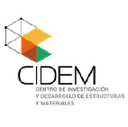Executive Secretary

IX International Symposium on Chemistry and Pharmaceutical Sciences
SIQF 2025
9th Symposium “Design, production and development of drugs” and 4th International Symposium “Chemistry of natural products”
Problem: Nanotechnology offers innovative solutions in materials science. Conventional syntheses of zinc oxide (ZnO) nanoparticles (NPs) often involve toxic reagents and unsustainable processes, posing environmental and health risks. In this context, there is a need to explore green synthesis routes and evaluate the biocompatibility of these NPs.
Objective(s): To synthesize zinc oxide nanorods (NR-ZnO) through green synthesis using an aqueous extract of Salvia rosmarinus as a natural reducing and stabilizing agent, and to analyze how reaction time and synthesis method (hydrothermal and microwave-assisted) influence their morphology and biocompatibility.
Methodology: NR-ZnO were obtained by hydrothermal synthesis (2, 4, and 6 hours) and microwave-assisted synthesis (30 min and 1 h), with and without the addition of the plant extract. The extract was prepared from fresh rosemary leaves. The nanomaterials were characterized by FTIR, XRD, and SEM. Biocompatibility was assessed through an in vitro hemolysis assay using sheep blood erythrocytes.
Results and Discussion: FTIR confirmed the presence of functional groups from the extract in the synthesized NR-ZnO, evidencing their functionalization. SEM images showed nanorod structures, more defined at longer reaction times, while XRD confirmed the hexagonal wurtzite phase. The hemolysis test demonstrated low hemolytic activity, indicating good hemocompatibility.
Conclusions: The NR-ZnO obtained through green synthesis exhibited controlled morphology and favorable biocompatibility, highlighting their potential as sustainable nanomaterials for future biomedical applications.
Problemática: La nanotecnología ofrece soluciones innovadoras en ciencia de materiales. Las síntesis convencionales de nanopartículas (NPs) de óxido de zinc (ZnO), puede implicar reactivos tóxicos y procesos poco sostenibles, generando riesgos ambientales y para la salud. En este sentido, surge la necesidad de explorar rutas de síntesis verde y evaluar la biocompatibilidad de estas NPs.
Objetivo(s): Sintetizar nanorods de óxido de zinc (NR-ZnO) mediante síntesis verde, empleando extracto acuoso de Salvia rosmarinus como agente reductor y estabilizante, y analizar cómo el tiempo de reacción y el método de síntesis (hidrotermal y microondas) influyen en su morfología y biocompatibilidad.
Metodología: Se obtuvieron NR-ZnO por síntesis hidrotermal (2, 4 y 6 horas) y asistida por microondas (30 min y 1 h), con y sin extracto vegetal. El extracto se preparó a partir de hojas frescas de romero. Los nanomateriales se caracterizaron por FTIR, XRD y SEM. La biocompatibilidad se evaluó mediante un ensayo de hemólisis in vitro usando eritrocitos de sangre de cordero.
Resultados y discusión: El FTIR evidenció la presencia de grupos funcionales del extracto en los NR-ZnO sintetizados, confirmando su funcionalización. El SEM mostró estructuras tipo nanorod, más definidas a mayor tiempo de reacción, mientras que el XRD confirmó la fase wurtzita hexagonal. El ensayo de hemólisis demostró una baja actividad hemolítica, indicando buena compatibilidad hemática.
Conclusiones: Los NR-ZnO obtenidos por síntesis verde presentan morfología controlada y biocompatibilidad favorable, destacando su potencial como nanomateriales sostenibles para futuras aplicaciones biomédicas.
About The Speaker

Dra. Deyani Nocedo-Mena

Discussion


 Gold
Gold
 Gold
Gold
 Silver
Silver
 Silver
Silver